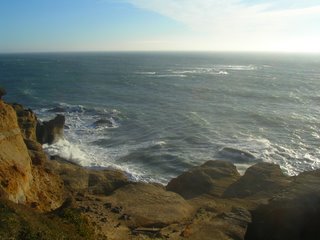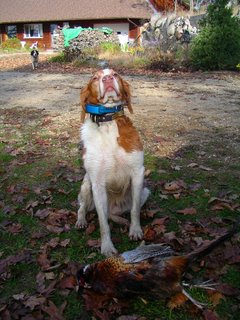 We ventured out to western Michigan for a morning pheasant hunt this week. We began walking the fields on a family farm right as dawn burned away the dark and the temperature hovered around twenty five degrees. Which made the blued steel of our 12 gauge Remington feel like a frozen lead pipe in our hands. The tall grass and stalks of corn were covered in thick frost, until the sun melted the frozen coating into a pants-soaking film of dewey moisture.
We ventured out to western Michigan for a morning pheasant hunt this week. We began walking the fields on a family farm right as dawn burned away the dark and the temperature hovered around twenty five degrees. Which made the blued steel of our 12 gauge Remington feel like a frozen lead pipe in our hands. The tall grass and stalks of corn were covered in thick frost, until the sun melted the frozen coating into a pants-soaking film of dewey moisture.
It was a perfect fall Michigan morning for a hunt, the kind you might read about in Sports Afield or Grays Sporting Journal. Golden leaves on poplar trees dropped to the ground one after another after another, with not the slightest hint of wind at blame. Three dogs (two brittanys and a yellow lab), rambled and jumped and sniffed every thicket and briar. We had to put the lab in the truck when it became obvious she was going into heat- the two male britannys were beginning to lose focus on finding birds and just wanted to do the humpity humpity dance. Minutes later, all primal distractions removed and on the edge of a grassy slough, the spaniels pointed in unison and a pair of pheasants cackled and jumped. We shot at the first rooster but missed as he flew into the sun. The second bird hit the ground with a thud. We walked another field and flushed two more cocks. All total, our combined harvest was three roosters. Not a bad day. It wouldn't have mattered if we had gotten skunked- coming away with a few birds is just the bonus. In a day or two, we'll cut the breast meat into thin strips and slice up jalepeno peppers and a red onion. We'll roll the pepper and onion slivers in the strips of pheasant meat and skewer with a toothpick. Then we'll cook the little rolls (this recipe would make a cat turd taste spicy and delicious) over charcoal and pan fry our last bag of Hen of the Woods mushrooms. We'll dip in ranch dressing and wash down with a Molson. Ain't a bad life.
We walked another field and flushed two more cocks. All total, our combined harvest was three roosters. Not a bad day. It wouldn't have mattered if we had gotten skunked- coming away with a few birds is just the bonus. In a day or two, we'll cut the breast meat into thin strips and slice up jalepeno peppers and a red onion. We'll roll the pepper and onion slivers in the strips of pheasant meat and skewer with a toothpick. Then we'll cook the little rolls (this recipe would make a cat turd taste spicy and delicious) over charcoal and pan fry our last bag of Hen of the Woods mushrooms. We'll dip in ranch dressing and wash down with a Molson. Ain't a bad life.
10.26.2006
Pheasant Hunt
10.23.2006
Museum of the Random and Absurd
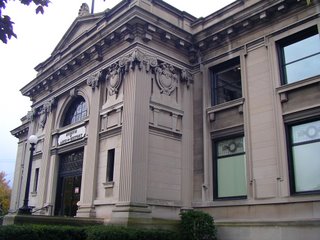 We were in Port Huron, MI, over the weekend with a couple of hours to kill before a family event. So we headed to the Museum of Arts and History, hoping to learn something about the local arts and history. Instead, what we found inside the building was perhaps the most random and disassociated collection of non-related items we've seen anywhere, except for weekend flea markets along the Tennessee interstate.
We were in Port Huron, MI, over the weekend with a couple of hours to kill before a family event. So we headed to the Museum of Arts and History, hoping to learn something about the local arts and history. Instead, what we found inside the building was perhaps the most random and disassociated collection of non-related items we've seen anywhere, except for weekend flea markets along the Tennessee interstate. The building housing the museum is remarkable. Built as a library in 1902 with massive blocks of Indiana limestone, it was paid for by Andrew Carnegie, the steel baron turned philanthropist who gave away his $350 million fortune before he died in 1915. In addition to the numerous highly-regarded institutions he created (Carnegie Hall and Carnegie Mellon University are among the many), three thousand of his libraries dot small towns across the U.S. and Europe. And judging from Port Huron structure, Carnegie spared no expense.
The building housing the museum is remarkable. Built as a library in 1902 with massive blocks of Indiana limestone, it was paid for by Andrew Carnegie, the steel baron turned philanthropist who gave away his $350 million fortune before he died in 1915. In addition to the numerous highly-regarded institutions he created (Carnegie Hall and Carnegie Mellon University are among the many), three thousand of his libraries dot small towns across the U.S. and Europe. And judging from Port Huron structure, Carnegie spared no expense.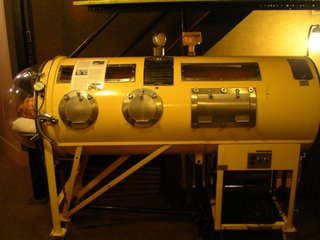 The library moved to a new and larger building in the 1960's, and so the building converted into a museum. We expected to find a regal collection of art and historical items inside, the kind that would illuminate Port Huron's rich history- first as trading post and fort in the 1700's and later as an affluent shipping hub in the golden era of the Great Lakes maritime transportation industry. While items from those days were on display, the exhibits were weighted heavily with the obscure and the irrelevant, often with complete disassociation: a porcelein doll collection is on display between miniature wooden ships and a violin shop; the iron lung machine (seen here) sits under a trophy muskellunge mount.
The library moved to a new and larger building in the 1960's, and so the building converted into a museum. We expected to find a regal collection of art and historical items inside, the kind that would illuminate Port Huron's rich history- first as trading post and fort in the 1700's and later as an affluent shipping hub in the golden era of the Great Lakes maritime transportation industry. While items from those days were on display, the exhibits were weighted heavily with the obscure and the irrelevant, often with complete disassociation: a porcelein doll collection is on display between miniature wooden ships and a violin shop; the iron lung machine (seen here) sits under a trophy muskellunge mount. Nestled between the World War II diorama and the Ladies of the Maccabee booth is the natural history collection. Various mammals sit encased in glass, many covered in dust and some so frail the hair has fallen off like they were siblings of the Velveteen rabbit. Framed butterflies cover the walls, many so old they've disintegrated into particulated ghosts. An elephant skull (presumably from Africa) sits on the ground next to mastodon bones recovered from a nearby farm. No attempt is made to illustrate where any these critters lived, how they lived, or what their connection is to the area. A school kid would leave the museum thinking elephants once roamed the banks of the St. Clair River alongside mastodons.
Nestled between the World War II diorama and the Ladies of the Maccabee booth is the natural history collection. Various mammals sit encased in glass, many covered in dust and some so frail the hair has fallen off like they were siblings of the Velveteen rabbit. Framed butterflies cover the walls, many so old they've disintegrated into particulated ghosts. An elephant skull (presumably from Africa) sits on the ground next to mastodon bones recovered from a nearby farm. No attempt is made to illustrate where any these critters lived, how they lived, or what their connection is to the area. A school kid would leave the museum thinking elephants once roamed the banks of the St. Clair River alongside mastodons.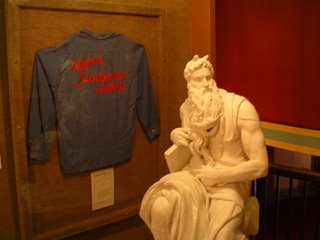 Upstairs, things get even more confusing. A Greek statue of a bearded gent with a tablet (we don't know our Greek fellows by sight, but he was probably a philosopher who profoundly influenced modern thought), is perched next to a Clikman's Sunbeam Bread shirt. If there is a connection between the two, it doesn't get transmitted, leaving us to come up with our own: in addition to being punctual and friendly, truck drivers at Clikman's were the intellectual giants of their time.
Upstairs, things get even more confusing. A Greek statue of a bearded gent with a tablet (we don't know our Greek fellows by sight, but he was probably a philosopher who profoundly influenced modern thought), is perched next to a Clikman's Sunbeam Bread shirt. If there is a connection between the two, it doesn't get transmitted, leaving us to come up with our own: in addition to being punctual and friendly, truck drivers at Clikman's were the intellectual giants of their time.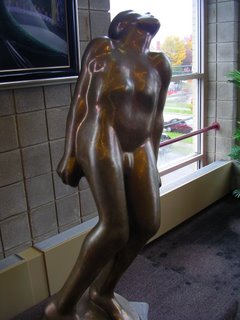 The "Arts" section of the museum was equally bizarre. As soon as we saw it was a hodgepodge of middle school art class submissions and the old paintings seen at any VFW hall, we turned and headed towards the door. We assume that's what this bronze statue is trying to do as well. But he's forever trapped amongst this most incongruant collection of common attic artifacts and garage sale artwork.
The "Arts" section of the museum was equally bizarre. As soon as we saw it was a hodgepodge of middle school art class submissions and the old paintings seen at any VFW hall, we turned and headed towards the door. We assume that's what this bronze statue is trying to do as well. But he's forever trapped amongst this most incongruant collection of common attic artifacts and garage sale artwork.
10.15.2006
World Series Bound!
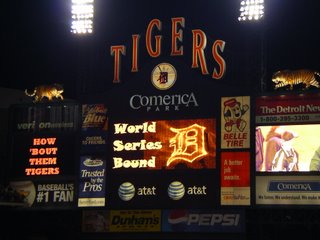 Saturday morning at 4 am, our brain fires off a half-lucid thought: go to game 4 of the ALCS. this has been a great year for the Tigers. hmmm. Wonder if any tickets are on the net.
Saturday morning at 4 am, our brain fires off a half-lucid thought: go to game 4 of the ALCS. this has been a great year for the Tigers. hmmm. Wonder if any tickets are on the net.
On the computer three minutes later: tickets everywhere. Ebay. Stubhub. Ticketpimp."Pick up tickets at the Thunderbird motel two hours before game start" Thunderbird motel, eh? Er, no thanks.
Hmmm. There's a pair on the Tigers website ticket exchange for thirty bucks over face value. Lower tier, first base line, twenty rows up. Hmmmm. Go back to bed and think about it and come back in a couple of hours.
Back on the computer three minutes later: buy those tickets. The Tigers have made it this far only twice in our life: in '68, when we were a zygote, and in '84, when we were still picking our nose in front of people.
One minute later, our printer was spitting out the tickets. Twelve hours later, we were at Comerica Park to watch the Tigers play the Oakland A's.
Twelve hours later, we were at Comerica Park to watch the Tigers play the Oakland A's. After twenty years of no playoff action and twelve straight losing seasons, long-suffering fans were anxious to wrap up the AL pennant race and have the Tigers play in the World Series. Detroit is, arguably, the best sports town in the country. Other than the Lions, the pro teams all have rich championship histories. Despite having the worst economy in the country and pending layoffs and a collapsing housing market, southeast Michigan is delirious right now. Karl Marx said religion is the opiate of the masses. In Detroit, it's professional sports.
After twenty years of no playoff action and twelve straight losing seasons, long-suffering fans were anxious to wrap up the AL pennant race and have the Tigers play in the World Series. Detroit is, arguably, the best sports town in the country. Other than the Lions, the pro teams all have rich championship histories. Despite having the worst economy in the country and pending layoffs and a collapsing housing market, southeast Michigan is delirious right now. Karl Marx said religion is the opiate of the masses. In Detroit, it's professional sports. A local news crew yelled at us to move while they were interviewing Mayor Kwame Kilpatrick. We pretended to be dim-witted and stood in place.
A local news crew yelled at us to move while they were interviewing Mayor Kwame Kilpatrick. We pretended to be dim-witted and stood in place. Beautiful fall day, cool and crisp and perfect for a ball game. Play ball!
Beautiful fall day, cool and crisp and perfect for a ball game. Play ball!
Back in early May, while at a Harrah's casino in Nevada, we bullshitted about baseball with a couple of guys at the sports bet counter. We asked what the payoff would be if we bet the Tigers would win the 2006 World Series. The team was off to a good start, but the season had just begun. After twelve years straight of cellar dwelling, the odds of the Tigers winning the World Series was something like 200 to 1. Now they're favored to win. We joked and laughed with the bookies about putting $100 on the team. Now we're crying we didn't. For much of the game, we wondered if the Tigers were going to pull off the W. Oakland had a 3-0 lead for the first several innings, until the Detroit tied the score at 3-3 in the sixth. Opportunities to take the lead in the seventh and eighth innings went unheeded. At the bottom of the ninth, with two men on base and two outs, just as we began to brace for extra innings and a possible loss, Magglio Ordonez rocketed a dinger over the left field wall. It was a moment of baseball greatness we'll never forget.
For much of the game, we wondered if the Tigers were going to pull off the W. Oakland had a 3-0 lead for the first several innings, until the Detroit tied the score at 3-3 in the sixth. Opportunities to take the lead in the seventh and eighth innings went unheeded. At the bottom of the ninth, with two men on base and two outs, just as we began to brace for extra innings and a possible loss, Magglio Ordonez rocketed a dinger over the left field wall. It was a moment of baseball greatness we'll never forget. While Ordonez ran the bases, the crowd went crazy. The decibel level must have been somewhere between a jet engine and a Who concert, circa 1976. The cheering continued for the next half-hour and didn't end until after the team was awarded the pennant.
While Ordonez ran the bases, the crowd went crazy. The decibel level must have been somewhere between a jet engine and a Who concert, circa 1976. The cheering continued for the next half-hour and didn't end until after the team was awarded the pennant.
 As the fans left the stadium and emptied into the streets, we were unsure what to expect; Detroit celebrations can spiral quickly into chaos and mayhem and overturned burning cop cars. Not this time, not at all. Instead, everywhere we looked we saw nothing but love: fans hugged each other and the bums in the streets. Traffic cops high-fived fans as they walked by. Detroit isn't the kind of town where strangers openly embrace and cops dish out high fives, but it was on October 14, 2006.
As the fans left the stadium and emptied into the streets, we were unsure what to expect; Detroit celebrations can spiral quickly into chaos and mayhem and overturned burning cop cars. Not this time, not at all. Instead, everywhere we looked we saw nothing but love: fans hugged each other and the bums in the streets. Traffic cops high-fived fans as they walked by. Detroit isn't the kind of town where strangers openly embrace and cops dish out high fives, but it was on October 14, 2006.Here's what Comerica Park looked and sounded like as Ordonez smacked a heaven sent three-run homer into the record books:
10.08.2006
Western Omelet
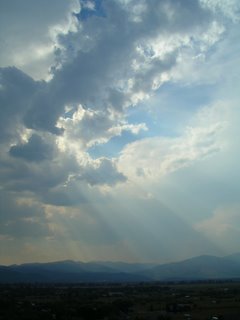 We'll close out the Idaho/Wyoming/Oregon thread with a big western omelet of random images that we omitted from the previous postings. It's time to move on, but we wanted to post these pictures for no other reason than we are too lazy to put our photos on disk and this is an easy way to archive. We'll keep the banter to a minimum, other than a note about location. That's another sign of laziness, but it's a beautiful fall day here and we have things to do. Like deal with a boat full of leaves and water because the cover blew off in a storm while we were away.
We'll close out the Idaho/Wyoming/Oregon thread with a big western omelet of random images that we omitted from the previous postings. It's time to move on, but we wanted to post these pictures for no other reason than we are too lazy to put our photos on disk and this is an easy way to archive. We'll keep the banter to a minimum, other than a note about location. That's another sign of laziness, but it's a beautiful fall day here and we have things to do. Like deal with a boat full of leaves and water because the cover blew off in a storm while we were away.
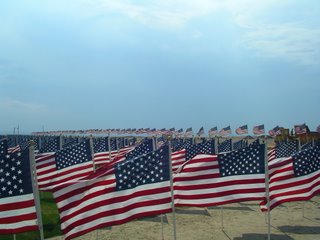 Near Twin Falls, Idaho, at a memorial called The Healing Field, thousands of flags were arranged in honor of the victims of 9/11.
Near Twin Falls, Idaho, at a memorial called The Healing Field, thousands of flags were arranged in honor of the victims of 9/11. The wind-bent and gnarled branches of a tree point towards an ocean beach.
The wind-bent and gnarled branches of a tree point towards an ocean beach. 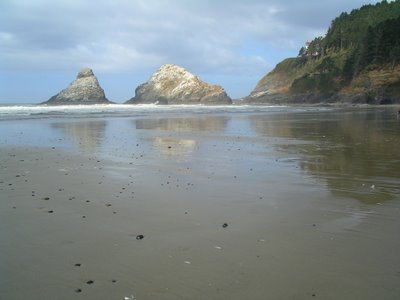 The Haceta Head Lighthouse overlooks a sandy ocean beach as low tide exposes thousands of tiny clams.
The Haceta Head Lighthouse overlooks a sandy ocean beach as low tide exposes thousands of tiny clams.Next: back in Michigan, as fall colors peak.
10.07.2006
Light Show
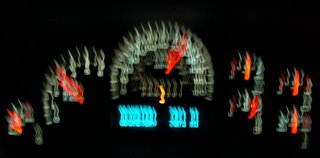 Driving home this evening after a few days in northern Michigan, a brilliant harvest moon lifted over the eastern horizon. We whipped out the camera and tried to take a few shots from the dashboard as we bulleted down the interstate. As we should have expected, the moon pics turned out lousy (while the moon loomed large on the horizon, in picture it looked like a tiny penlight floating in the sky). But something unintentional happened: some of the photos captured a remarkable dashboard lightshow.
Driving home this evening after a few days in northern Michigan, a brilliant harvest moon lifted over the eastern horizon. We whipped out the camera and tried to take a few shots from the dashboard as we bulleted down the interstate. As we should have expected, the moon pics turned out lousy (while the moon loomed large on the horizon, in picture it looked like a tiny penlight floating in the sky). But something unintentional happened: some of the photos captured a remarkable dashboard lightshow. Wispy ribbons of color dance like kite tails in the wind. What's probably just our radio looks like waves of energy cascading down a cosmic fountain. Or maybe it's the dashboard again. Sometimes the most interesting images are the ones least expected or the least explainable.
Wispy ribbons of color dance like kite tails in the wind. What's probably just our radio looks like waves of energy cascading down a cosmic fountain. Or maybe it's the dashboard again. Sometimes the most interesting images are the ones least expected or the least explainable. Light + velocity = some pretty whack images.
Light + velocity = some pretty whack images.
10.04.2006
City by the Sea
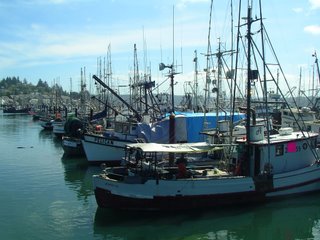 West of Corvalis, Oregon, the Yaquina River drops from the temperate rainforest of the coastal mountains and broadens into a wide estuary before flowing into the Pacific Ocean. On Yaquina Bay sits the fishing village of Newport, home to 10,000 people and hundreds of trawlers and seiner boats. The town is a salty mix of watermen who eke out a living pulling crabs and tuna from the sea and tourist-laden taverns, restaurants, and art galleries. Local roads are clogged with motorhomes and rental cars with out-of-state license plates, like our convertible.
West of Corvalis, Oregon, the Yaquina River drops from the temperate rainforest of the coastal mountains and broadens into a wide estuary before flowing into the Pacific Ocean. On Yaquina Bay sits the fishing village of Newport, home to 10,000 people and hundreds of trawlers and seiner boats. The town is a salty mix of watermen who eke out a living pulling crabs and tuna from the sea and tourist-laden taverns, restaurants, and art galleries. Local roads are clogged with motorhomes and rental cars with out-of-state license plates, like our convertible.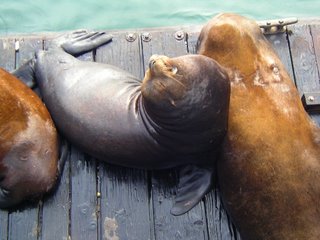 Fat sea lions lounge on the docks and bark in loud chorus. It's a lazy life they live, thanks to an endless supply of scraps from the commercial fish houses. They sit half-asleep with their backs arched, foam bubbling from their whiskered mouths. All of a sudden, often without reason, a lion will begin to yelp orrt orrt orrt. His buddies will join in song for several minutes until they grow bored of the noise and silence returns. But not for long. As soon as an unpopular lion swims by or worse, jumps on the dock, the cacophony begins again.
Fat sea lions lounge on the docks and bark in loud chorus. It's a lazy life they live, thanks to an endless supply of scraps from the commercial fish houses. They sit half-asleep with their backs arched, foam bubbling from their whiskered mouths. All of a sudden, often without reason, a lion will begin to yelp orrt orrt orrt. His buddies will join in song for several minutes until they grow bored of the noise and silence returns. But not for long. As soon as an unpopular lion swims by or worse, jumps on the dock, the cacophony begins again. Of all the places to stay in Newport, the most interesting is the Sylvia Beach Hotel. Perched on a high bluff overlooking the ocean, the hotel is a haven for book readers. On the top floor sits a comfortable library with easy chairs positioned in front of a million dollar view. Each of the seventeen rooms have been decorated in honor of a famous author. In the Edgar Allen Poe room, a pendulum blade swings from the ceiling and a false door opens to brick wall and the dangling tip of a jester's cap, homage to The Pit and the Pendulum and The Cask of Amontillado. We stayed in the F. Scott Fitzgerald ("show me a hero and I will write you a tragedy") room and were greeted by three bottles of gin on the wall mantle. Gin, eh? Makes perfect sense. Other rooms included the Hemingway room, the Mark Twain room, the Melville room, and the Tennessee Williams room.
Of all the places to stay in Newport, the most interesting is the Sylvia Beach Hotel. Perched on a high bluff overlooking the ocean, the hotel is a haven for book readers. On the top floor sits a comfortable library with easy chairs positioned in front of a million dollar view. Each of the seventeen rooms have been decorated in honor of a famous author. In the Edgar Allen Poe room, a pendulum blade swings from the ceiling and a false door opens to brick wall and the dangling tip of a jester's cap, homage to The Pit and the Pendulum and The Cask of Amontillado. We stayed in the F. Scott Fitzgerald ("show me a hero and I will write you a tragedy") room and were greeted by three bottles of gin on the wall mantle. Gin, eh? Makes perfect sense. Other rooms included the Hemingway room, the Mark Twain room, the Melville room, and the Tennessee Williams room. Back on the Newport waterfront, the Barge Inn proudly boasts their customer base: wino's, dingbat's, and riff raff. Gotta love the place for being honest. Unlike the pretentious Ann Arbor establishments, with their unearned air of elitism and entitlement, the Barge Inn knows the exact place in the universe their customers come from. In a world full of posers and placaters, romeos and robots, the Barge Inn is a port in a storm.
Back on the Newport waterfront, the Barge Inn proudly boasts their customer base: wino's, dingbat's, and riff raff. Gotta love the place for being honest. Unlike the pretentious Ann Arbor establishments, with their unearned air of elitism and entitlement, the Barge Inn knows the exact place in the universe their customers come from. In a world full of posers and placaters, romeos and robots, the Barge Inn is a port in a storm.
Over on the docks, after one of the sea lions jumped on his buddy, the crowd goes nuts:
10.03.2006
The Edge of Oregon
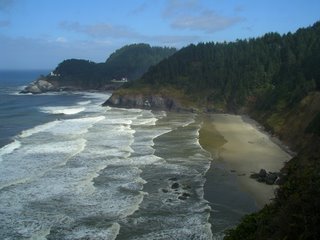 One of the most incredible scenic drives in the United States is the sixty miles of U.S. 101 between Newport and Florence, Oregon. We've motored other parts of the Coast Highway (which spans from Washington State to the southern end of California), and while exceptional vistas and romantic beaches are abundant throughout, this portion has more beauty per square mile than just about anywhere in North America.
One of the most incredible scenic drives in the United States is the sixty miles of U.S. 101 between Newport and Florence, Oregon. We've motored other parts of the Coast Highway (which spans from Washington State to the southern end of California), and while exceptional vistas and romantic beaches are abundant throughout, this portion has more beauty per square mile than just about anywhere in North America. What makes this section of coastline so magnificant is the dramatic diversity of landscape: high terraces run for miles before tapering into broad sandy beaches. Coastal mountains (some of which eventually reach elevations of over 4,000 feet), start (or end?) as prominent rock croppings that extend into the sea. Mountain rivers carve deep gorges and meet the sea in wildlife-rich estuaries. The warm moist air of the Pacific brings ample rainfall (over 100 inches a year), producing thick forests of towering Western Hemlocks and Douglas Firs.
What makes this section of coastline so magnificant is the dramatic diversity of landscape: high terraces run for miles before tapering into broad sandy beaches. Coastal mountains (some of which eventually reach elevations of over 4,000 feet), start (or end?) as prominent rock croppings that extend into the sea. Mountain rivers carve deep gorges and meet the sea in wildlife-rich estuaries. The warm moist air of the Pacific brings ample rainfall (over 100 inches a year), producing thick forests of towering Western Hemlocks and Douglas Firs. For centuries, the Siletz Indians inhabited the region, enjoying an abundant bounty of food that would have made inland tribes envious. The sea provided an endless source of salmon and shellfish, and the forest produced nuts, berries, and elk. Archeologists believe this is why the Siletz were one of the only sedantary hunter-gatherer societies that ever existed; other indigenous people were perpetually moving between summer and winter camps in search of sustainable food supplies. Archeologists also believe this treasure-trove of food allowed the Siletz to pursue more leisure interests than other tribes, as reflected in the craftsmanship of their intricately-carved totem poles.
For centuries, the Siletz Indians inhabited the region, enjoying an abundant bounty of food that would have made inland tribes envious. The sea provided an endless source of salmon and shellfish, and the forest produced nuts, berries, and elk. Archeologists believe this is why the Siletz were one of the only sedantary hunter-gatherer societies that ever existed; other indigenous people were perpetually moving between summer and winter camps in search of sustainable food supplies. Archeologists also believe this treasure-trove of food allowed the Siletz to pursue more leisure interests than other tribes, as reflected in the craftsmanship of their intricately-carved totem poles. At land's end, ancient rocks frosted with the poop of seabirds mark the gateway to an ocean universe. On a previous trip, we ventured out to sea on a charter boat to fish for sea bass and lin cod. Several miles away from shore, massive swells lifted the boat up, then dropped us down into a valley of water. Over and over again. Every third or fourth wave was a huge roller that spun the tiny gyroscope in our inner-ear like a paint mixer at the hardware store. Within minutes, we were feeling sick. Within an hour, we were looking at the bay leaves from the previous night's lasagna in our shoelaces. Two dramamines did little to remedy the situation- they were on the boat floor before the next wave hit. We love the ocean, the salty mist and sound of crashing waves, but can only enjoy it from the edge.
At land's end, ancient rocks frosted with the poop of seabirds mark the gateway to an ocean universe. On a previous trip, we ventured out to sea on a charter boat to fish for sea bass and lin cod. Several miles away from shore, massive swells lifted the boat up, then dropped us down into a valley of water. Over and over again. Every third or fourth wave was a huge roller that spun the tiny gyroscope in our inner-ear like a paint mixer at the hardware store. Within minutes, we were feeling sick. Within an hour, we were looking at the bay leaves from the previous night's lasagna in our shoelaces. Two dramamines did little to remedy the situation- they were on the boat floor before the next wave hit. We love the ocean, the salty mist and sound of crashing waves, but can only enjoy it from the edge.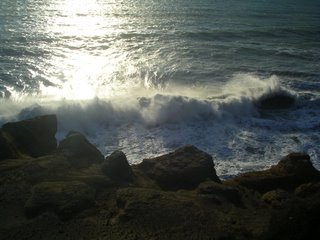 Men go abroad to wonder at the heights of the mountains, at the huge waves of the sea, at the long courses of the rivers, at the vast compass of the ocean, at the circular motions of the stars, and they pass by themselves without wondering.
Men go abroad to wonder at the heights of the mountains, at the huge waves of the sea, at the long courses of the rivers, at the vast compass of the ocean, at the circular motions of the stars, and they pass by themselves without wondering.
-Saint Augustine
There's not much we can add after that profound little nugget, so we'll just let the ocean speak:

